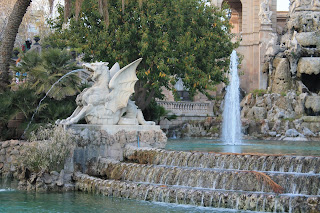Eine Zitadelle gibt es hier nicht mehr. Phillip V. hat sie errichten lassen nachdem die Stadt in spanischen Erbfolgekrieg besetzt wurde. Ein wuchtiges monumentales sternförmiges Bauwerk und Bollwerk, um jeden katalanischen Widerstand im Keim zu ersticken. Aber Soldaten hat die Festung nie beherbergt, statt dessen wurde sie Gefängnis und damit nicht beliebter.
1878 ließ General Prim ( http://de.wikipedia.org/wiki/Juan_Prim ) die Festung abreißen und einen Park anlegen, für das Volk. Das hat ihn beliebt gemacht, noch heute gibt es ein Denkmal für ihn.
Alle Gebäude wurde nicht zerstört, geblieben sind das Arsenal, das heute vom katalanischen Parlament genutzt wird, der Gouverneurspalast, heute eine Schule ist und die Kapelle, die heute manchmal vom Militär genutzt wird.
Der Jardin du Luxembourg in Paris war das Vorbild, und so entstand eine weitläufige Parklandschaft, die lange Zeit die Einzige in der Stadt war. 1888 fand hier die Weltausstellung statt und die dafür errichteten Bauten beherbergen heute mehrere Museen.
Es gibt einen See, auf dem man Boot fahren kann, den Zoo von Barcelona, viele exotische Pflanzen, freilaufende Hunde und gut gelaunte Menschen.
Ein Highlight ist ein Wasserfall, der einem Triumphbogen entspringt und dessen Figuren von verschiedenen katalanischen Künstlern geschaffen wurden, zentrales Thema ist die Geburt der Venus, aber wir finden auch Aurora, mehrere Djinns, Eros, Faune und Drachen. Diese sind zurückzuführen auf die Mitwirkung eines jungen Architekturstudenten namens Antonio Gaudí.
A citadel is no longer to be found here. Phillip V. let it build after the city was defeated in the War of Spanish Succession. A massive, monumental star shaped fort and bastion, to quench any catalan resistance from the very begin. But they never were soldiers in the fort, but it became a prison. Didn't made the building more populair for the citizens.
1878 General Prim ( http://en.wikipedia.org/wiki/Juan_Prim,_1st_Marquis_of_los_Castillejos ) gave order to demolish the bastion and to make a park out of it, for the people. That made him very populair and still today is there a memorial for him in the park.
Not all the buildings were destroyed, three left, the Arsenal, today the house of the catalan parliament, the govenor's palace, today a school and a chapel, today sometimes used by the army.
The Jadin du Luxembourg was the model and so a rambling park landscape was created, wich was longe time the only one in town. 1888 the World Exibition took place here and the houses from this area are used today as museums.
There is a lake there, where people can boating, the Zoo of Barcelona, there are lots of exotic plants, free running dogs and lots of folks in good mood.
A highlight is the waterfall coming down from a triumphal arch with many sculptures made by catalan artists, main theme is the birth of Venus, but even Aurora, many djinns, fauns and Eros can be found, and dragons. The reason why is, a young architect student took part in the decoration, his name Antonio Gaudì.

































































